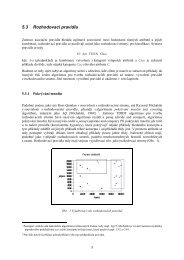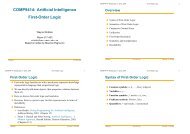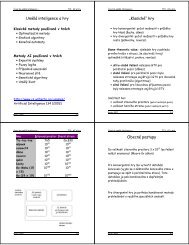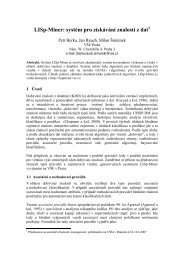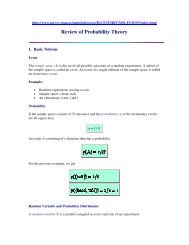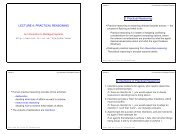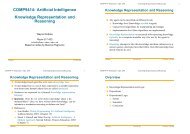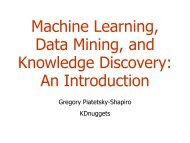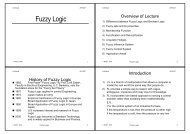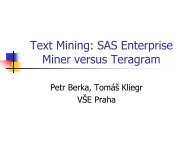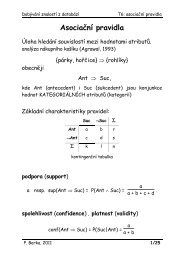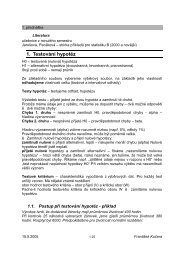COMP9414: Artificial Intelligence Informed Search - Sorry
COMP9414: Artificial Intelligence Informed Search - Sorry
COMP9414: Artificial Intelligence Informed Search - Sorry
You also want an ePaper? Increase the reach of your titles
YUMPU automatically turns print PDFs into web optimized ePapers that Google loves.
<strong>COMP9414</strong>, Wednesday 23 March, 2005 <strong>Informed</strong> <strong>Search</strong> 2<br />
<strong>COMP9414</strong>: <strong>Artificial</strong> <strong>Intelligence</strong><br />
<strong>Informed</strong> <strong>Search</strong><br />
Wayne Wobcke<br />
Room J17-433<br />
wobcke@cse.unsw.edu.au<br />
Based on slides by Maurice Pagnucco<br />
Overview<br />
Heuristics<br />
<strong>Informed</strong> <strong>Search</strong> Methods<br />
◮ Best-First <strong>Search</strong><br />
◮ Greedy <strong>Search</strong><br />
◮ A ∗ <strong>Search</strong><br />
◮ Iterative Deepening A ∗ <strong>Search</strong><br />
Conclusion<br />
<strong>COMP9414</strong> c○UNSW, 2005<br />
<strong>COMP9414</strong> c○UNSW, 2005 Generated: 24 March 2005<br />
<strong>COMP9414</strong>, Wednesday 23 March, 2005 <strong>Informed</strong> <strong>Search</strong> 1<br />
<strong>COMP9414</strong>, Wednesday 23 March, 2005 <strong>Informed</strong> <strong>Search</strong> 3<br />
<strong>Informed</strong> (Heuristic) <strong>Search</strong><br />
Heuristics<br />
We have seen that uninformed methods of search are capable of<br />
systematically exploring the state-space in finding a goal state<br />
However, uninformed search methods are very inefficient in most<br />
cases<br />
With the aid of problem-specific knowledge, informed methods of<br />
search are more efficient<br />
References:<br />
◮ Ivan Bratko, Prolog Programming for <strong>Artificial</strong> <strong>Intelligence</strong>,<br />
Addison-Wesley, 2001. (Chapter 12)<br />
◮ Stuart J. Russell and Peter Norvig, <strong>Artificial</strong> <strong>Intelligence</strong>: A<br />
Modern Approach, Second Edition, Pearson Education, 2003<br />
(Chapter 4)<br />
Heuristics are “rules of thumb”<br />
“Heuristics are criteria, methods or principles for deciding which<br />
among several alternative courses of action promises to be the most<br />
effective in order to achieve some goal.”<br />
Judea Pearl, Heuristics<br />
Can make use of heuristics in deciding which is the most “promising”<br />
path to take during search<br />
In search, heuristic must be an underestimate of actual cost to get<br />
from current node to goal — an admissible heuristic<br />
Denoted h(n); h(n) = 0 whenever n is a goal node<br />
<strong>COMP9414</strong> c○UNSW, 2005 Generated: 24 March 2005<br />
<strong>COMP9414</strong> c○UNSW, 2005 Generated: 24 March 2005
<strong>COMP9414</strong>, Wednesday 23 March, 2005 <strong>Informed</strong> <strong>Search</strong> 4<br />
Heuristics — Example<br />
<strong>COMP9414</strong>, Wednesday 23 March, 2005 <strong>Informed</strong> <strong>Search</strong> 6<br />
Heuristics — Example<br />
8-Puzzle — number of tiles out of place<br />
2 8 3<br />
1<br />
2<br />
3<br />
Another common heuristic is the straight-line distance (“as the crow<br />
flies”) from node to goal<br />
1 6 4<br />
8<br />
4<br />
n<br />
7 5<br />
Therefore, h(n) = 5<br />
7<br />
6<br />
5<br />
Therefore, h(n) = distance from n to g<br />
g<br />
<strong>COMP9414</strong> c○UNSW, 2005 Generated: 24 March 2005<br />
<strong>COMP9414</strong> c○UNSW, 2005 Generated: 24 March 2005<br />
<strong>COMP9414</strong>, Wednesday 23 March, 2005 <strong>Informed</strong> <strong>Search</strong> 5<br />
Heuristics — Example<br />
<strong>COMP9414</strong>, Wednesday 23 March, 2005 <strong>Informed</strong> <strong>Search</strong> 7<br />
Best-First <strong>Search</strong><br />
8-Puzzle — Manhattan distance (distance tile is out of place)<br />
2 8 3 1 2 3<br />
1 6 4 8 4<br />
7 5 7 6 5<br />
function BestFirst<strong>Search</strong>(problem, EvalFn) returns solution sequence<br />
inputs: problem — a problem<br />
EvalFn — evaluation function<br />
QueueingFn ← function that orders nodes by EvalFn<br />
return General<strong>Search</strong>(problem, QueueingFn)<br />
Therefore, h(n) = 1 + 1 + 0 + 0 + 0 + 1 + 1 + 2 = 6<br />
<strong>COMP9414</strong> c○UNSW, 2005 Generated: 24 March 2005<br />
<strong>COMP9414</strong> c○UNSW, 2005 Generated: 24 March 2005
<strong>COMP9414</strong>, Wednesday 23 March, 2005 <strong>Informed</strong> <strong>Search</strong> 8<br />
Greedy <strong>Search</strong><br />
<strong>COMP9414</strong>, Wednesday 23 March, 2005 <strong>Informed</strong> <strong>Search</strong> 10<br />
A ∗ <strong>Search</strong><br />
Idea: expand node with the smallest estimated cost to reach the goal<br />
Use heuristic function h(n) to select node from frontier for expansion<br />
(i.e. use h(n) as EvalFn in Best-First <strong>Search</strong>)<br />
Greedy <strong>Search</strong> — Analysis<br />
Similar to depth-first search — tends to follow a single path to goal<br />
Not optimal, incomplete<br />
Time O(b m ); Space O(b m )<br />
However, good heuristic can reduce time and space complexity<br />
significantly<br />
Idea: Use both cost of path generated thus far and estimate to goal to<br />
select node from frontier to expand<br />
g(n) = cost of path from start node to n<br />
Accomplished by using an evaluation function f (n) = g(n) + h(n)<br />
f (n) represents the estimated cost of the cheapest solution passing<br />
through n<br />
Expand node from frontier with smallest f -value<br />
Essentially combines uniform-cost search and greedy search<br />
<strong>COMP9414</strong> c○UNSW, 2005 Generated: 24 March 2005<br />
<strong>COMP9414</strong> c○UNSW, 2005 Generated: 24 March 2005<br />
<strong>COMP9414</strong>, Wednesday 23 March, 2005 <strong>Informed</strong> <strong>Search</strong> 9<br />
Greedy <strong>Search</strong><br />
<strong>COMP9414</strong>, Wednesday 23 March, 2005 <strong>Informed</strong> <strong>Search</strong> 11<br />
A ∗ Algorithm<br />
8 3<br />
2 1 4<br />
7 6 5<br />
(4)<br />
2<br />
7<br />
8 3<br />
1 4<br />
6 5<br />
8 3<br />
2 1 4<br />
7 6 5<br />
2 8 3<br />
1 6 4<br />
7 5<br />
(3)<br />
(3)<br />
8 1 3<br />
(4)<br />
8 1 3<br />
2 4 2 4<br />
7 6 5<br />
7 6 5<br />
(5)<br />
8 1 3<br />
2 4<br />
7 6 5<br />
2 8 3<br />
(3)<br />
2<br />
1 4<br />
1<br />
7 6 5<br />
7<br />
2<br />
7<br />
(3)<br />
8 3<br />
1 4<br />
6 5<br />
(4)<br />
(4)<br />
8 1 3<br />
(4)<br />
2 6 4<br />
7 5<br />
2 3<br />
1 8 4<br />
7 6 5<br />
1 2 3<br />
8 4<br />
7 6 5<br />
1 2 3<br />
8 4<br />
7 6 5<br />
2<br />
1<br />
7<br />
2<br />
1<br />
7<br />
8<br />
6<br />
8<br />
6<br />
(2)<br />
(1)<br />
(0)<br />
3<br />
4<br />
5<br />
3<br />
4<br />
5<br />
(4)<br />
(3)<br />
3<br />
(3)<br />
2 8 3<br />
8 4<br />
1 4<br />
6 5<br />
7 6 5<br />
1<br />
7<br />
2<br />
8<br />
6<br />
2<br />
1<br />
7<br />
3<br />
4<br />
5<br />
3<br />
8<br />
6<br />
4<br />
5<br />
(2)<br />
(4)<br />
(4)<br />
2 8 3<br />
(5)<br />
1 6 4<br />
7 5<br />
OPEN — nodes on frontier; CLOSED – expanded nodes<br />
OPEN = {〈s, nil〉}<br />
while OPEN is not empty<br />
remove from OPEN the pair 〈n, p〉 with minimal f (n)<br />
place 〈n, p〉 on CLOSED<br />
if n is a goal node return success (path p)<br />
for each edge e connecting n and n ′ with cost c<br />
if 〈n ′ , p ′ 〉 is on CLOSED and p ⊕ e is cheaper than p ′<br />
then remove n ′ from CLOSED and put 〈n ′ , p ⊕ e〉 on OPEN<br />
else if 〈n ′ , p ′ 〉 is on OPEN and p ⊕ e is cheaper than p ′<br />
then replace p ′ with p ⊕ e<br />
else if n ′ is not on OPEN then put 〈n ′ , p ⊕ e〉 on OPEN<br />
return failure<br />
<strong>COMP9414</strong> c○UNSW, 2005 Generated: 24 March 2005<br />
<strong>COMP9414</strong> c○UNSW, 2005 Generated: 24 March 2005
<strong>COMP9414</strong>, Wednesday 23 March, 2005 <strong>Informed</strong> <strong>Search</strong> 12<br />
<strong>COMP9414</strong>, Wednesday 23 March, 2005 <strong>Informed</strong> <strong>Search</strong> 14<br />
A ∗ <strong>Search</strong><br />
% extend path by each node in Succs and insert into Paths in order of costs<br />
extend_path([], _, _, Paths, Paths).<br />
% no more paths<br />
2 8 3<br />
(1+5=6)<br />
1 6 4<br />
7 5<br />
2<br />
1<br />
7<br />
8<br />
6<br />
3<br />
4<br />
5<br />
2 8 3<br />
1 4<br />
7 6 5<br />
(0+4=4)<br />
(1+3=4)<br />
2 8 3<br />
(1+5=6)<br />
1 6 4<br />
7 5<br />
extend_path([S|Succs], Path, Cost, Paths, Paths2) :-<br />
Path = [LastNode|_],<br />
s(LastNode, S, C),<br />
NewCost is Cost + C,<br />
% g(S) = NewCost<br />
h(S, H),<br />
% h(S) = estimate S->Soln<br />
NewEst is NewCost + H,<br />
% f(S) = estimate of node’s value<br />
insert([S|Path], NewCost, NewEst, Paths, Paths1),<br />
extend_path(Succs, Path, Cost, Paths1, Paths2).<br />
% insert path in order in the list of paths<br />
insert(Path, Cost, Estimate, [], [[Path, Cost]]).<br />
8 3<br />
2 1 4<br />
7 6 5<br />
(3+3=6)<br />
2 8 3<br />
1 4<br />
7 6 5<br />
2 8 3<br />
7 1 4<br />
6 5<br />
(2+3=5)<br />
(3+4=7)<br />
2 3<br />
1 8 4<br />
7 6 5<br />
2 3<br />
1 8 4<br />
7 6 5<br />
(3+2=5)<br />
(2+3=5)<br />
2 3<br />
1 8 4<br />
7 6 5<br />
(3+4=7)<br />
2 8 3<br />
1 4<br />
7 6 5<br />
(2+4=6)<br />
insert(Path, Cost, Estimate, Paths, [[Path, Cost]|Paths]) :-<br />
Paths = [Path1|_],<br />
Path1 = [[Last1|_], Cost1],<br />
h(Last1, H),<br />
Estimate1 is Cost1 + H,<br />
Estimate1 > Estimate.<br />
% new path is better<br />
1<br />
7<br />
2<br />
8<br />
6<br />
3<br />
4<br />
5<br />
(4+1=5)<br />
insert(Path, Cost, Estimate, [Path1|Paths], [Path1|Paths1]) :-<br />
insert(Path, Cost, Estimate, Paths, Paths1).<br />
1 2 3<br />
(5+0=5)<br />
8 4<br />
7 6 5<br />
1 2 3<br />
(5+2=7)<br />
7 8 4<br />
6 5<br />
<strong>COMP9414</strong> c○UNSW, 2005 Generated: 24 March 2005<br />
<strong>COMP9414</strong> c○UNSW, 2005 Generated: 24 March 2005<br />
<strong>COMP9414</strong>, Wednesday 23 March, 2005 <strong>Informed</strong> <strong>Search</strong> 13<br />
A ∗ <strong>Search</strong><br />
<strong>COMP9414</strong>, Wednesday 23 March, 2005 <strong>Informed</strong> <strong>Search</strong> 15<br />
A ∗ <strong>Search</strong> — Analysis<br />
% Best-First <strong>Search</strong><br />
% A simplified version of Bratko Fig. 12.3<br />
% Store paths and costs g(n) in a list of paths, ordered according to f(n)<br />
% Nodes in a path are listed in reverse order, i.e. list [t,g,f,e,s]<br />
% represents path s->e->f->g->t<br />
% <strong>Search</strong> from the start node Start for path Solution, call ?- bestfirst(Start, Solution)<br />
bestfirst(Start, Solution) :-<br />
astar([[[Start], 0]], Solution).<br />
astar([BestPath|Paths], Path) :-<br />
BestPath = [Path, Cost],<br />
Path = [LastNode|_],<br />
goal(LastNode).<br />
astar([BestPath|Paths], Solution) :-<br />
BestPath = [Path, Cost],<br />
Path = [LastNode|_],<br />
extend(Path, Cost, Paths, NewPaths),<br />
astar(NewPaths, Solution).<br />
Optimal (optimally efficient)<br />
Complete<br />
Number of nodes searched (and stored) still exponential in the worst<br />
case<br />
It has been shown that this will be the case unless the error in the<br />
heuristic grows no faster than the actual path cost<br />
|h(n) − h ∗ (n)| ≤ O(log h ∗ (n))<br />
For many heuristics, this error is at least proportional to the path cost!<br />
% extend best path by successors of last node<br />
extend(Path, Cost, Paths, NewPaths) :-<br />
Path = [LastNode|_],<br />
findall(S, s(LastNode, S, _), Succs),<br />
not(Succs = []),<br />
extend_path(Succs, Path, Cost, Paths, NewPaths).<br />
<strong>COMP9414</strong> c○UNSW, 2005 Generated: 24 March 2005
<strong>COMP9414</strong>, Wednesday 23 March, 2005 <strong>Informed</strong> <strong>Search</strong> 16<br />
Admissibility of the A ∗ Algorithm<br />
<strong>COMP9414</strong>, Wednesday 23 March, 2005 <strong>Informed</strong> <strong>Search</strong> 18<br />
Proof of the Optimality of the A ∗ Algorithm<br />
We can impose conditions on graphs and the heuristic function h(n)<br />
to guarantee that the A ∗ algorithm, applied to these graphs, always<br />
finds an optimal solution<br />
Admissibility basically means an optimal solution is found (provided<br />
a solution exists) and it is the first solution found<br />
Conditions on state-space graph<br />
◮ Each node has a finite number of successors<br />
◮ Every arc in the graph has a cost greater than some ε > 0<br />
Condition on heuristic h(n)<br />
◮ For every node n, the heuristic never overestimates (i.e. h(n) ≤<br />
h ∗ (n) where h ∗ (n) is the actual cost from n to the goal — h(n) is<br />
an optimistic estimator)<br />
Let G be an optimal goal state and the optimal path cost be f ∗<br />
Let G 2 be a suboptimal goal state (i.e. g(G 2 ) > f ∗ )<br />
Suppose that A ∗ has selected G 2 from the frontier for expansion<br />
Consider node n that is a leaf (i.e. on frontier) on an optimal path to G<br />
Now f ∗ ≥ f (n)<br />
Also, if n is not chosen for expansion over G 2 , then f (n) ≥ f (G 2 )<br />
Therefore, f ∗ ≥ f (G 2 )<br />
Since G 2 is a goal state h(G 2 ) = 0<br />
so f (G 2 ) = g(G 2 ) + h(G 2 ) = g(G 2 )<br />
Hence f ∗ ≥ g(G 2 )<br />
Contradiction #<br />
<strong>COMP9414</strong> c○UNSW, 2005 Generated: 24 March 2005<br />
<strong>COMP9414</strong> c○UNSW, 2005 Generated: 24 March 2005<br />
<strong>COMP9414</strong>, Wednesday 23 March, 2005 <strong>Informed</strong> <strong>Search</strong> 17<br />
Admissibility of the A ∗ Algorithm<br />
<strong>COMP9414</strong>, Wednesday 23 March, 2005 <strong>Informed</strong> <strong>Search</strong> 19<br />
Completeness of the A ∗ Algorithm<br />
A ∗ is optimally efficient for a given heuristic: of the optimal search<br />
algorithms that expand search paths from the root node it can be<br />
shown that there is no other optimal algorithm that will expand fewer<br />
nodes in finding a solution<br />
Monotonic heuristic — along any path, the f -cost never decreases<br />
Common property of admissible heuristics<br />
If this property does not hold then we can use the following “trick” to<br />
modify the path cost for a node n ′ which is a child of node n<br />
(Pathmax Equation) f (n ′ ) = max( f (n), g(n ′ ) + h(n ′ ))<br />
Let G be an optimal goal state<br />
The only way that A ∗ won’t reach a goal state is if there are infinitely<br />
many nodes where f (n) ≤ f ∗<br />
This can only occur if there is a node with infinite branching factor or<br />
there is a path with a finite cost but with infinitely many nodes<br />
The former is taken care of by our first condition on the state graph<br />
The fact that arc costs are above some ε > 0 means that g(n) > f ∗ for<br />
some node n, taking care of the latter<br />
<strong>COMP9414</strong> c○UNSW, 2005 Generated: 24 March 2005<br />
<strong>COMP9414</strong> c○UNSW, 2005 Generated: 24 March 2005
<strong>COMP9414</strong>, Wednesday 23 March, 2005 <strong>Informed</strong> <strong>Search</strong> 20<br />
<strong>COMP9414</strong>, Wednesday 23 March, 2005 <strong>Informed</strong> <strong>Search</strong> 22<br />
Heuristics — Properties<br />
We say h 2 dominates h 1 iff h 2 (n) ≥ h 1 (n) for any node n<br />
A ∗ will expand fewer nodes on average using h 2 than h 1<br />
We observe that every node for which f (n) < f ∗ will be expanded<br />
Which means n is expanded whenever h(n) < f ∗ − g(n)<br />
But since h 2 (n) ≥ h 1 (n), any node expanded using h 2 will be<br />
expanded using h 1<br />
It is always better to use a heuristic with higher (underestimating)<br />
values<br />
Suppose you have identified a number of non-overestimating<br />
heuristics for a problem h 1 (n), h 2 (n), ..., h k (n)<br />
Then max i≤k h i (n) is a more powerful non-overestimating heuristic<br />
Therefore can design a whole range of heuristics to trap special cases<br />
<strong>COMP9414</strong> c○UNSW, 2005 Generated: 24 March 2005<br />
Iterative Deepening A ∗ <strong>Search</strong><br />
IDA ∗ performs repeated depth-bounded depth-first searches as in<br />
Iterated Deepening, however the bound is based on f (n) instead of<br />
depth<br />
Start by using f -value of initial state<br />
If search ends without finding a solution, repeat with new bound of<br />
minimum f -value exceeding previous bound<br />
IDA ∗ is optimal and complete with the same provisos as A ∗<br />
Due to depth-first search, space complexity = O( b f ∗<br />
δ ) (where δ =<br />
smallest operator cost and f ∗ = optimal solution cost) — often O(bd)<br />
is a reasonable approximation<br />
Another variant — SMA ∗ (Simplified Memory-Bounded A ∗ ) —<br />
makes full use of memory to avoid expanding previously expanded<br />
nodes<br />
<strong>COMP9414</strong> c○UNSW, 2005 Generated: 24 March 2005<br />
<strong>COMP9414</strong>, Wednesday 23 March, 2005 <strong>Informed</strong> <strong>Search</strong> 21<br />
<strong>COMP9414</strong>, Wednesday 23 March, 2005 <strong>Informed</strong> <strong>Search</strong> 23<br />
Generating Heuristics<br />
Admissible heuristics can be derived from the exact<br />
solution cost of a relaxed version of the problem<br />
If the rules of the 8-puzzle are relaxed so that a tile can move<br />
anywhere, then #tiles-out-of-place gives the shortest solution<br />
If the rules are relaxed so that a tile can move to any adjacent square,<br />
then Manhattan distance gives the shortest solution<br />
For TSP: let path be any structure that connects all cities<br />
=⇒ minimum spanning tree heuristic<br />
Conclusion<br />
<strong>Informed</strong> search makes use of problem-specific knowledge to guide<br />
progress of search<br />
This can lead to a significant improvement in the performance of<br />
search<br />
Much research has gone into admissible heuristics<br />
Even on the automatic generation of admissible heuristics<br />
<strong>COMP9414</strong> c○UNSW, 2005 Generated: 24 March 2005<br />
<strong>COMP9414</strong> c○UNSW, 2005 Generated: 24 March 2005



